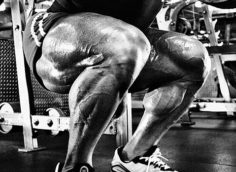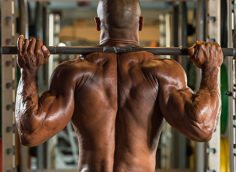It was 1976. The movie was "Stay Hungry" and it starred Jeff Bridges and Sally Field and a bulky newcomer named Arnold Schwarzenegger.
It was Arnold's first big movie role and he played a bodybuilder who was training for the Mr. Universe contest. Okay, so it wasn't much of a stretch, acting-wise, but Arnie ended up winning a Golden Globe anyhow.
There's a scene where Arnold's character, Joe Santos, is showing Craig Blake, played by Bridges, how to work out on one of those chrome, multi-functional Universal workout stations that was a mainstay in most gyms of that time period.
Craig, however, anxious to show Joe that he's not a complete neophyte, hops onto one of those old-time hyperextension benches:

Craig: "I think we had something like this in high school. I'm not sure I still got the form down right. Tell me if I'm doing this right.
Joe: I never do that one..." (Walks away dismissively).
I smirked when I first saw that scene because the hyperextension was one of those Gym 101 exercises practiced by rank newbies, usually at the behest of their physical therapists. Serious lifters didn't do them. And that's pretty much how most of us still regard the hyperextension.
I mean, if you really want to build the glutes, hamstrings, and spinal erectors, you do Romanian deadlifts or cable pull-throughs or any one of a dozen or so exercises – not hyperextensions, right?
Maybe not. Vidar Andersen, a scientist at the Western Norway University of Applied Science, believes that hyperextensions are superior to Romanian deadlifts for developing the glutes and hamstrings and he's got the receipts to prove it.
Norwegian Girls Training for the Annual Lutefisk Bob
Andersen recruited 15 experienced female lifters and wired up their erector spinae, biceps femorum, and glutei maximi while they performed hyperextensions (on the Roman chair), Romanian deadlifts, and machine back extensions.

He found the hyperextension produced more consistent torque throughout the movement while activating muscle fibers in the glutes 23% more than the Romanian deadlift. The hyperextension was also more effective in activating the biceps femorum than the other exercises. There were no differences between the three exercises, however, in activating the erector spinae.
"For athletes and recreationally active people aiming to optimize the neuromuscular activation of the glutes and hamstrings, we would particularly recommend the Roman chair (hyperextension) exercise," wrote Andersen.
Lab, Schmab, What About Real-Life Stuff?
As I said, I used to be somewhat dismissive of the hyperextension, too, until I read what Charles Staley had to say about the movement. He uses them to buttress up his deadlift, but he believes that they're incredibly effective at building the glutes and hamstrings, as long as you do them loaded – heavily loaded.
Charles routinely does high-rep sets (10-12) with a 150-pound dumbbell clutched to his chest. He'd use even bigger dumbbells but his cheap-ass gym doesn't carry anything heavier.
I took Charles' advice and started doing them with heavier weights. I was only using 90 pounds on them but based on the reactions of some of the other gym members, you'd think I was Björnsson and I'd just uprooted an inconveniently located oak tree.
The only reason I mention that is to illustrate how alien a concept it is to really load the hyperextension. Sure, you see guys using 45-pound plates all the time, but rarely anything heavier. It's probably because of the belief that the lower back is fragile and not to be f*cked with in such a manner; that, or the belief that the hyperextension is just for old guys who need to stay spry for their next pickleball match.
Fears of spines snapping in two appear to be misguided, though. Muscle-phys guy Bret Contreras says he's never had a client experience an injury from them... as long as they perform the movement as a hip extension motion rather than a lumbar extension motion:
"You want to keep the spine fairly neutral throughout the range of motion, get a big hamstring stretch down low while in hip extension, and squeeze the glutes at lockout in hip extension."
Back Extension Fine Points
Like any exercise, hyperextensions are most useful when you respect the exercise. Charles Staley recommends the following:
- Hips must be forward of the pad. This is a pure hinge maneuver, so make sure your ability to flex and extend from the hips isn't impeded by the pad.
- Seek maximum range of motion. Go all the way down and all the way up to parallel.
- Match lifting tempo to resistance curve. As you move through extension, start the concentric rep somewhat slowly, and then accelerate as you move towards full extension to compensate for worsening leverages.
- Keep your entire spine neutral, including your neck (don't look up as you reach full extension).
How to Load Them and When to Do Them
Once you decide to venture past the 45-pound plate hyperextension, you've got several options on what to use. Obviously, you can hold a heavy dumbbell, kettlebell, sandbag, or Norwegian girl to your chest. Resistance bands would also work (one end looped around the front supportive legs of the Roman chair and the other around your neck).
Staley recommends sets of 8 to 15 done right after your pulls or on the following workout. Personally, I just include them as another glute/hamstring exercise on pull days.
Reference
- Vidar Andersen, et al. "Comparison of Muscle Activity in Three Single-Joint, Hip Extension Exercises in Resistance-Trained Women," Journal of Sports Science and Medicine, (2021) 20, 181-187.





